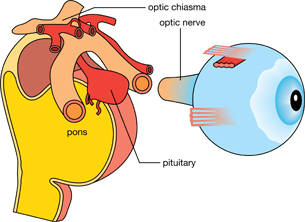Module 2
1. Module 2
1.1. Big Picture
Module 2—The Endocrine System
 Big Picture
Big Picture

©Mikhail Lavrenov/StockXpert
Stressed! Stressed out! Ready to explode! People deal with stress every day. You might deal with it by eating a bag of cookies, or you might find that your body needs only sleep to recover. Your body needs to adjust to external and internal stresses, or changes, so they do not become a detriment to your health. Staying healthy means making appropriate “choices” in how your body, and you, identify and cope with stress.
Consider the case study of Emily, a 30-year-old woman who lives with the constant stress of an endocrine disorder. Her career goals and life plans are continually interrupted by her health issues.
When she was in Grade 12, Emily developed extreme fatigue and complained that her whole body ached. Even her bones hurt! She felt weak and began finding it very difficult to keep up with the reading and homework her teachers assigned. She also noticed that she couldn’t focus the microscope in the lab and, at times, her vision was blurred. It was at this point that her parents took her to see a series of physicians and medical specialists. After extensive tests and consultations, Emily’s doctors confirmed that she had a rare, inherited endocrine disorder called familial multiple endocrine neoplasia type 1 (FMEN1). In Unit C you will learn how Emily inherited this disorder, and you will come to understand how this disorder impacts Emily’s daily life and, potentially, her longevity.

In FMEN1 specific endocrine glands, such as the parathyroid glands, pituitary gland, pancreas, and adrenal glands, or a combination of all, become overactive due to the growth of mostly benign (non-cancerous) tumours called neoplasms. These tumours disrupt normal function by crowding nearby structures and cells. For example, a tumour in the pituitary gland can press against surrounding pituitary tissue, thereby damaging the normal part of the tiny pituitary gland or the nerves that carry visual information from the eyes. In the diagram to the left, notice the very close arrangement of the pituitary gland and the optic nerve. This is one reason why Emily’s vision was blurred. In this module you will learn about the endocrine system from Emily’s perspective and experiences with FMEN1.
In this module you will explore the big question of how the body uses chemical messengers to respond to stimuli, including stress, to establish homeostasis.
In Module 2 you will explore the following focusing questions:
- How is the endocrine system organized, and how do its parts communicate with each other and other parts of the body?
- Who is the “boss” of the endocrine system, and how is control of the endocrine system managed?
- How do the major endocrine glands, including the anterior and posterior pituitary gland, the thyroid gland, the parathyroid glands, the pancreas, and the adrenal glands, contribute to homeostasis?
- What are the metabolic roles fulfilled by hormones in the maintenance of homeostasis, and what are the physiological consequences of hormonal imbalances?
- How do the nervous and the endocrine systems interact to maintain overall homeostasis?
In your journey through the endocrine system, you will find the answers to the focusing questions. These questions are also very similar to those that Emily and her parents asked her doctors. In particular, Emily and her family wanted to know what medical technologies could control the homeostatic imbalances so that Emily could try to lead as normal a life as possible.
To help you organize the concepts you learn in Module 2, and to provide you with a study aid for review before you complete the Module Assessment, you may choose to download the Concept Organizer for Module 2. Fill in this concept organizer with the ideas you master as you work through each lesson, or prepare the organizer when you have completed Module 2. You can use keywords, point form, or any amount of detail that meets your needs. You may choose to work from the file on your computer, print the document and work from the paper copy, or copy the outline onto a large sheet of poster paper. After you have prepared your concept organizer, you may wish to check your work with the concept organizer provided in the Module Summary. The concept organizer provided outlines some of the key topics that you should include in each lesson of your concept organizer. This is a great tool to review and use for study purposes, but using this organizer is completely your choice.
The Module Assessment for Module 2 will present you with a case study involving research data from two people, one of whom is Emily. Your assessment will be a written response based on analysis of the research data. You will be expected to integrate and explain concepts, describe processes, identify technological solutions, and illustrate your skill in drawing graphs and feedback loops. When you have completed the module, go to the Module Summary and Assessment page for details about the case study and an evaluation rubric.